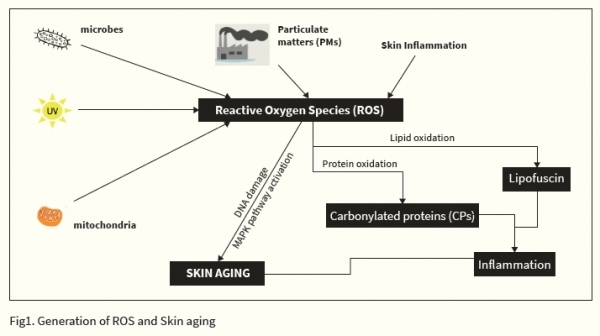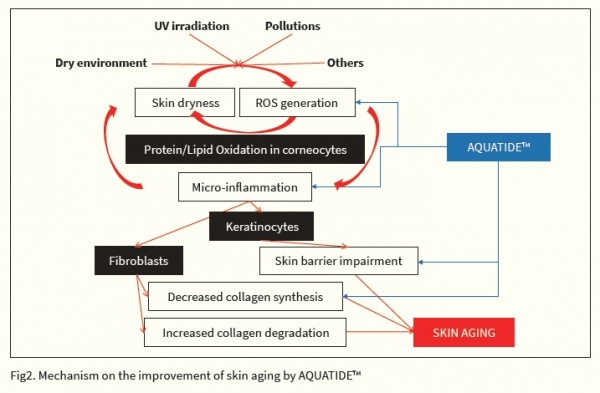IncosFarm Co., Ltd. Ki-don, Park
Abstract
Oxygen-induced oxidative stress, which alters the function and structure of all biomaterials such as proteins, lipids, carbohydrates, and ultimately causes aging, is an inevitable byproduct of oxygen-breathing organisms. Reactive Oxygen SpeciesROS, which are generated by external stimuli such as ultraviolet rays, heat, and fine dust as well as the generation of oxygen radicals by respiration, cause oxidative stress. The living body uses various antioxidant mechanisms to cope with this oxidative stress. Antioxidant systems in vivo include enzyme systems that directly eliminate oxidative stress using antioxidants such as vitamin E and enzyme systems that decompose reactive oxygen species such as Superoxide dismutaseSOD to reduce oxidative stress. In particular, skin is the first organ that physically interacts with the outside of the body and is therefore constantly exposed to the most diverse types of oxidative stress. The purpose of this article is to describe the changes of skin caused by oxidative stress and the antioxidant system in skin, especially in terms of the regulation mechanism of antioxidant system through autophagy.
Introduction
In living organisms that obtain energy through oxygen breathing, oxidative stress by oxygen is an inevitable side effect that must be tolerated for the production of high efficiency energy. Reactive oxygen species is a word that refers to various oxygen radical molecules generated by hydrogen peroxide generated in the mitochondria at the last stage of oxygen respiration (S. Miwa, F. L. Muller and K. B. Beckman, 2008). These species exist in many different forms, including superoxides, hydroxyl radical, hydroxyperoxide radical, which can oxidize other proteins, lipids, and DNA. Among the various aging theories that explain the causes and pathways of aging, the free radical theory explains that these reactive oxygen species cause damage at the molecular level in genetic material, proteins, lipids, etc., and the accumulation of such damage causes aging at the scale of the cell, tissue, and organ (Rinnerthaler, Bischof, Streubel, Trost, & Richter, 2015). Thus, effective control of free radicals should inhibit the aging process and to control many degenerative diseases or changes associated with aging.
In order to cope with such oxidative stress, various antioxidant systems are operating in living organisms. The antioxidant system is largely composed of two systems: one enzymatic, the other non-enzymatic. In the enzyme-based antioxidant system, enzymes such as superoxide dismutaseSOD, catalase, and glutathione peroxidase are directly involved in the degradation of breaking down radicals (Yang & Lee, 2015). In the nonenzymatic system, it is known that reactive oxygen species are eliminated through antioxidant substances such as vitamin C, vitamin E, CoQ10, and beta-carotene (Gašperlin & Gosenca, 2011). In addition, an enzymatic system that removes or corrects damage caused by oxidative stress, especially in genes, is also well known.

Skin and oxidative stress
The skin can be regarded as an organ that performs the function of maintaining homeostasis in response to the external environment from the outermost part of the human body. This barrier function essential for the survival of the living body is known to be mainly performed by the epidermis, especially the stratum corneum. Damage to this barrier is considered to be a factor causing not only dry, sensitive, and pigmented skin, but also local inflammation of the skin. In addition to the oxidative stress caused by respiration, the skin may directly undergo oxidative damage, since it is a tissue directly in contact with the external environment (Poljsak, Dahmane, & Godic, 2013). For example, it has been reported that various radical substances are produced in a cell when exposed to a strong energy source such as ultraviolet or X-rays. In fact, recent reports suggest that even relatively low energy light such as infrared rays or blue light can cause oxidative stress (Mamalis, Koo, & Jagdeo, 2016). In addition, various organic compounds and heavy metals in particulate matterPM have also been suggested to cause oxidative stress in skin (Kim, Cho, & Park, 2016), (Vierkötter et al., 2010).
Lipofuscin, which is one of the main substances caused by oxidative stress of skin, is a substance made by combining proteins, lipids and carbohydrates, and has been reported as a cause of age spots formed by pigmentation common in aging process (Höhn, Sittig, Jung, Grimm, & Grune, 2012). Therefore, there is a continuing effort to develop a whitening agent or an antiaging cosmetic ingredient that uses a lowmolecular substance or a natural extract that can inhibit lipofuscin formation or eliminate already-produced lipofuscin. Carbonylated protein, which is produced by the oxidation of proteins, is also suggested as one of the main causes of aging of the skin. In particular, in the stratum corneum, which is the outermost part of the skin, carbonylated proteins lower transparency, deteriorate skin barrier function, and decrease moisture (J Dermatol Sci (2016) 84: e133). Recently, it have been reported that the amount of carbonylated proteins in the stratum corneum correlates with the elasticity of the skin. In particular, it has been shown that the application of a substance having the effect of activating autophagy in the skin cells can prevent the production of these carbonylated proteins (Lim et al., 2018).

Autophagy and oxidative stress
Autophagy is a process in which cells decompose intracellular organelles in response to changes in the external environment, including the lack of nutrients, and recycle them for intracellular energy sources (Young & Narita, 2010). In addition to these energy maintenance and regulatory functions, autophagy is also known to play a role in protecting cells from damaged organelles or external microorganisms.
In addition, autophagy has been shown to remove substances or intracellular organelles damaged by oxidative stress, and it plays a role in regulating the expression of many enzymes involved in the antioxidant system in cells (Li, Tan ,Lee, Giordano, & Zhang, 2012; Lim et al., 2017). As such, a variety of cosmetic raw materials and products based these mechanisms has been researched and developed. Recently, a large number of raw materials and products have been introduced. However, the majority of these materials are mainly based on natural products, and their effects on the cell or skin level are not clear. Recently, AQUATIDE™, an autophagic active ingredient developed by the authors, has been shown to activate autophagy in skin cells by binding to sirtuin protein (Lim et al., 2017). AQUATIDE™, a peptide derivative, has also been shown to strongly inhibit cell damage caused by oxidative stress. In addition to its antioxidant effect, AQUATIDE™ itself has also been shown to stimulate the production of antioxidants such as peroxiredoxin, heat shock protein 70, and heat shock protein 90.
These antioxidant effects have been clinically proven to have effects such as a decrease in protein carbonylation and increased elasticity in the skin (Lim et al., 2018). A systematic study on the autophagy mechanism is expected to develop a variety of raw materials and technologies that can effectively control
oxidative stress. As a new cosmetic product, it can be expected to improve wrinkles and prevent skin pigmentation.
REFERENCES
1. Gašperlin, M., & Gosenca, M. (2011). Main approaches for delivering antioxidant vitamins through the skin to prevent skin ageing. Expert Opinion on Drug Delivery, 8(7), 905-919.
2. Höhn, A., Sittig, A., Jung, T., Grimm, S., & Grune, T. (2012). Lipofuscin is formed independently of macroautophagy and lysosomal activity in stress-induced prematurely senescent human fibroblasts. Free Radic Biol Med, 53(9), 1760-1769.
3. Kim, K. E., Cho, D., & Park, H. J. (2016). Air pollution and skin diseases: Adverse effects of airborne particulate matter on various skin diseases. Life Sci, 152, 126-134.
4. Lee, J., Giordano, S., & Zhang, J. (2012). Autophagy, mitochondria and oxidative stress: cross-talk and redox signalling. Biochem J, 441(2), 523-540.
5. Li, L., Tan, J., Miao, Y., Lei, P., & Zhang, Q. (2015). ROS and Autophagy: Interactions and Molecular Regulatory Mechanisms. Cellular and Molecular Neurobiology, 35(5), 615-621.
6. Lim, C. J., Lee, Y. M., Kang, S. G., Lim, H. W., Shin, K. O., Jeong, S. K. et al. (2017). Aquatide Activation of SIRT1 Reduces Cellular Senescence through a SIRT1-FOXO1-Autophagy Axis. Biomol Ther (Seoul), 25(5), 511-518.
7. Lim, J., Lim, C. J., Kim, S., Nam, G., Chang, M., Park, K. et al. (2018). Antiaging and antioxidant effects of topical autophagy activator: A randomized, placebo-controlled, double-blinded study. J Cosmet Dermatol.
8. Mamalis, A., Koo, E., & Jagdeo, J. (2016). Resveratrol
9. Prevents Reactive Oxygen Species–Induced Effects of Light-Emitting Diode–Generated Blue Light in Human Skin Fibroblasts. Dermatologic Surgery, 42(6), 727-732.
10. Miwa, S, Muller, F. L. & Beckman K. B. (2008) The Basics of Oxidative Biochemistry. In S. Miwa, K. B. Beckman and F. L. Muller. (Eds.) Oxidative Stress in Aging. (11-38). Towata, NJ: Humana Press
11. Poljsak, B., Dahmane, R., & Godic, A. (2013). Skin and antioxidants. J Cosmet Laser Ther, 15(2), 107-113.
12. Rinnerthaler, M., Bischof, J., Streubel, M. K., Trost, A., & Richter, K. (2015). Oxidative stress in aging human skin. Biomolecules, 5(2), 545-589.
13. Vierkötter, A., Schikowski, T., Ranft, U., Sugiri, D., Matsui, M., Krämer, U. et al. (2010). Airborne Particle Exposure and Extrinsic Skin Aging. Journal of Investigative Dermatology, 130(12), 2719-2726.
14. Yang, H.-Y., & Lee, T.-H. (2015). Antioxidant enzymes as redox-based biomarkers: a brief review. BMB Reports, 48(4), 200-208.
15. Young, A. R. J., & Narita, M. (2010). Connecting autophagy to senescence in pathophysiology. Current Opinion in Cell Biology, 22(2), 234-240.

